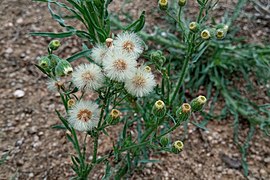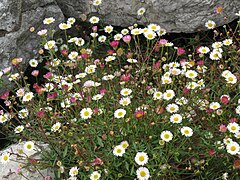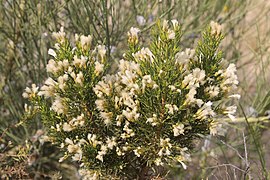Lachnophyllester
| Strukturformel | ||||||||||
|---|---|---|---|---|---|---|---|---|---|---|

| ||||||||||
| Allgemeines | ||||||||||
| Name | Lachnophyllester | |||||||||
| Summenformel | C11H12O2 | |||||||||
| Externe Identifikatoren/Datenbanken | ||||||||||
| ||||||||||
| Eigenschaften | ||||||||||
| Molare Masse | 176,21 g·mol−1 | |||||||||
| Sicherheitshinweise | ||||||||||
| ||||||||||
| Soweit möglich und gebräuchlich, werden SI-Einheiten verwendet. Wenn nicht anders vermerkt, gelten die angegebenen Daten bei Standardbedingungen (0 °C, 1000 hPa). | ||||||||||
Lachnophyllester ist ein Fettsäureester, konkret der Methylester der Lachnophyllsäure.
Vorkommen
[Bearbeiten | Quelltext bearbeiten]Natürlich kommt vor allem die Z-Verbindung vor. Zuerst isoliert wurde sie aus Lachnophyllum gossypinum und war eine der ersten natürlich entdeckten Diin-Verbindungen.[2] Sie ist außerdem enthalten in mehreren Arten der Berufkräuter, Gattungen Conyza und Erigeron enthalten, sowie in Blumea lacera.[3][4][5] Weiterhin kommt sie im Blattwachs von Baccharis linearis vor, sowie in anderen Arten der Gattung Bacharis.[6][7][8][9] Im Pilz Clitozybe rhizophora ist sie ein Intermediat bei der Biosynthese von Diin-Triolen.[10]
-
Erigeron bonariensis
-
Conyza canadiensis
-
Erigeron karvinskianus
-
Baccharis linearis
In Gänseblümchen kommt die E-Verbindung vor.[11] In Erigeron mucronatus und Baccharis trinervis kommen beide Isomere vor.[12][13]
Synthese
[Bearbeiten | Quelltext bearbeiten]Ausgehend von (Z)-Pent-2-en-4-in-1-ol kann Lachnophyllsäure synthetisiert werden. Diese kann mit Diazomethan zum Methylester methyliert werden.[14]
Eigenschaften
[Bearbeiten | Quelltext bearbeiten]Lachnophyllester wirkt cytotoxisch gegen mehrere Krebszelllinien und fungizid gegen verschiedene Pilzarten. Außerdem wirkt er antibakteriell gegen diverse Bakterienarten, unter anderem Escherichia coli, Bacillus cereus, Staphylococcus aureus und Pseudomonas aeruginosa. Lachnophyllester hat zudem eine insektizide Wirkung gegen den Afrikanischen Baumwollwurm (Spodoptera littoralis aus der Familie der Eulenfalter).[5][7][12]
Einzelnachweise
[Bearbeiten | Quelltext bearbeiten]- ↑ Dieser Stoff wurde in Bezug auf seine Gefährlichkeit entweder noch nicht eingestuft oder eine verlässliche und zitierfähige Quelle hierzu wurde noch nicht gefunden.
- ↑ Ian Bell, E. R. H. Jones, M. C. Whiting: 266. Researches on acetylenic compounds. Part LXI. The synthesis of three polyacetylenic esters. In: Journal of the Chemical Society (Resumed). 1958, S. 1313, doi:10.1039/jr9580001313.
- ↑ Tran Minh Hoi, Le Thi Huong, Hoang Van Chinh, Dang Viet Hau, Prabodh Satyal, Thieu Anh Tai, Do Ngoc Dai, Nguyen Huy Hung, Vu Thi Hien, William N Setzer: Essential Oil Compositions of Three Invasive Conyza Species Collected in Vietnam and Their Larvicidal Activities against Aedes aegypti, Aedes albopictus, and Culex quinquefasciatus. In: Molecules. Band 25, Nr. 19, 7. Oktober 2020, S. 4576, doi:10.3390/molecules25194576, PMID 33036394, PMC 7583829 (freier Volltext).
- ↑ Vinod Kumar, C.S. Mathela, Geeta Tewari, Darshan Singh, A.K. Tewari, K.S. Bisht: Chemical composition and antifungal activity of essential oils from three Himalayan Erigeron species. In: LWT - Food Science and Technology. Band 56, Nr. 2, Mai 2014, S. 278–283, doi:10.1016/j.lwt.2013.12.007.
- ↑ a b Prabodh Satyal, Bhuwan K. Chhetri, Noura S. Dosoky, Samon Shrestha, Ambika Poudel, William N. Setzer: Chemical Composition of Blumea lacera Essential Oil from Nepal. Biological Activities of the Essential Oil and (Z)-Lachnophyllum Ester. In: Natural Product Communications. Band 10, Nr. 10, Oktober 2015, S. 1934578X1501001, doi:10.1177/1934578X1501001028.
- ↑ C. Labbe, J. Rovirosa, F. Faini, M. Mahu, A. San-Martin, M. Castillo: Secondary Metabolites from Chilean Baccharis species. In: Journal of Natural Products. Band 49, Nr. 3, Mai 1986, S. 517–518, doi:10.1021/np50045a025.
- ↑ a b Francesca Faini, Cecilia Labbé, Josep Coll: Seasonal changes in chemical composition of epicuticular waxes from the leaves of Baccharis linearis. In: Biochemical Systematics and Ecology. Band 27, Nr. 7, Oktober 1999, S. 673–679, doi:10.1016/S0305-1978(98)00131-8.
- ↑ A. Patricio Rivera, Luis Arancibia, Mariano Castillo: Clerodane Diterpenoids and Acetylenic Lactones from Baccharis Paniculata. In: Journal of Natural Products. Band 52, Nr. 2, März 1989, S. 433–435, doi:10.1021/np50062a045.
- ↑ Maria Rose Jane R. Albuquerque, Elnatan B. Souza, Maria Usileide D.S. Lins, Nadja A.P. Nogueira, Telma Leda G. Lemos, Edilberto R. Silveira, Otília Deusdênia L. Pessoa: Composition and antimicrobial activity of the essential oil from aerial parts of Baccharis trinervis (Lam.) Pers. In: Arkivoc. Band 2004, Nr. 6, 2. August 2004, S. 59–65, doi:10.3998/ark.5550190.0005.608.
- ↑ G. C. Barley, A. C. Day, U. Graf, Ewart R. H. Jones, I. O’Neill, R. Tachikawa, V. Thaller, R. A. Vere Hodge: Natural acetylenes. Part XXXIII. The biogenesis of the C9 diacetylenic triol from the fungus Clitocybe rhizophora velen. In: Journal of the Chemical Society C: Organic. 1971, S. 3308, doi:10.1039/j39710003308.
- ↑ Dagny Holme, Nils Andreas Sörensen, Erling Tjus, R. H. Burris: Studies Related to Naturally Occurring Acetylene Compounds. XV. The Isolation of trans-Lachnophyllum Ester from Bellis perennis L. In: Acta Chemica Scandinavica. Band 8, 1954, S. 280–283, doi:10.3891/acta.chem.scand.08-0280.
- ↑ a b Bahlul Z. Awen, C. Ramachandra Unnithan, Subban Ravi, Akoni J. Lakshmanan: GC-MS Analysis, Antibacterial Activity and Genotoxic Property of Erigeron mucronatus Essential Oil. In: Natural Product Communications. Band 5, Nr. 4, April 2010, S. 1934578X1000500, doi:10.1177/1934578X1000500426.
- ↑ Maria Rose Jane R. Albuquerque, Elnatan B. Souza, Maria Usileide D.S. Lins, Nadja A.P. Nogueira, Telma Leda G. Lemos, Edilberto R. Silveira, Otília Deusdênia L. Pessoa: Composition and antimicrobial activity of the essential oil from aerial parts of Baccharis trinervis (Lam.) Pers. In: Arkivoc. Band 2004, Nr. 6, 2. August 2004, S. 59–65, doi:10.3998/ark.5550190.0005.608.
- ↑ Ian Bell, E. R. H. Jones, M. C. Whiting: 266. Researches on acetylenic compounds. Part LXI. The synthesis of three polyacetylenic esters. In: Journal of the Chemical Society (Resumed). 1958, S. 1313, doi:10.1039/jr9580001313.



